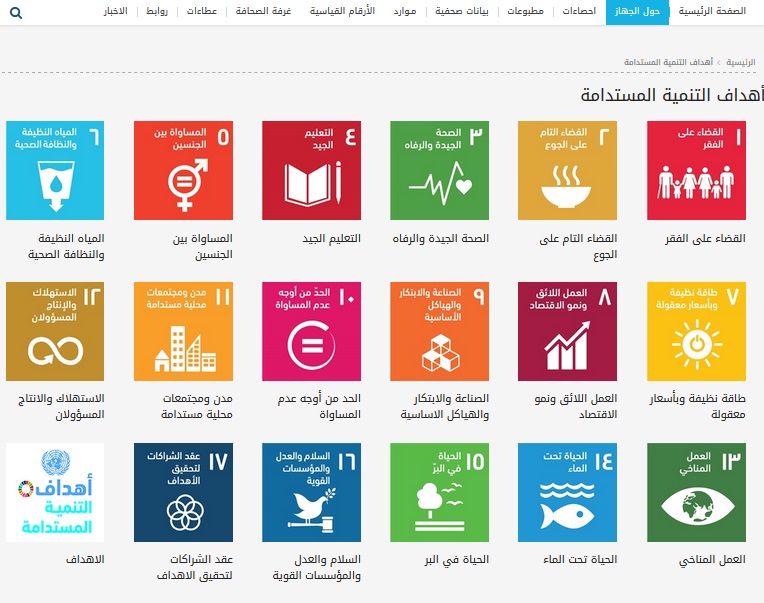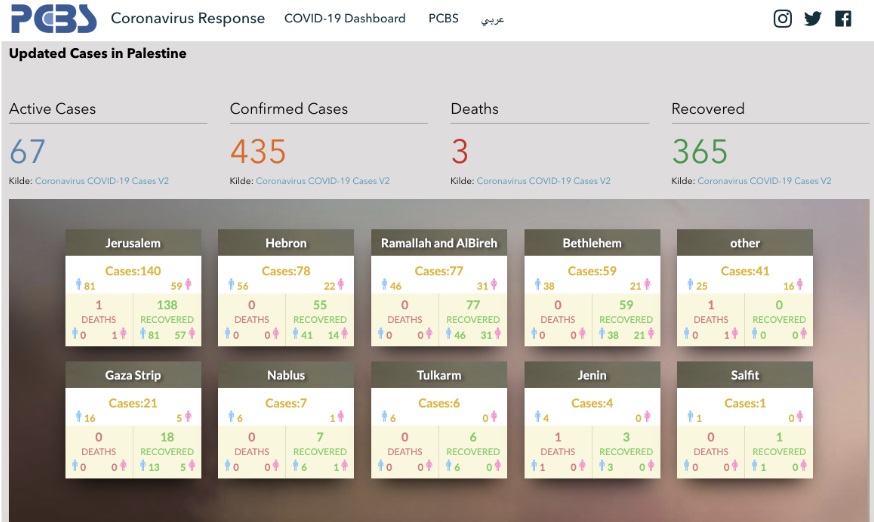State of Palestine
I. General on SDG monitoring set up
National SDG organizational set up
‘The Palestinian council of ministers issued a decree establishing a national team to lead the implementation of the SDGs under the overview of the PMO. Tasked with coordination for the implementation and follow-up of the SDGs amongst all related stakeholders, including members from NGOs and the private sector. Led by the PMO, the establishment of the National SDG Team was based on lessons learned from the MDGs to allow different partners to participate in the monitoring and implementation of the SDGs in all stages of the process, from prioritisation to implementation and evaluation. The responsibility of the team is to determine sustainable development priorities in Palestine and integrate them within the national framework for planning and budgeting processes, lead and coordinate the preparation of national reviews of progress towards the SDGs.’
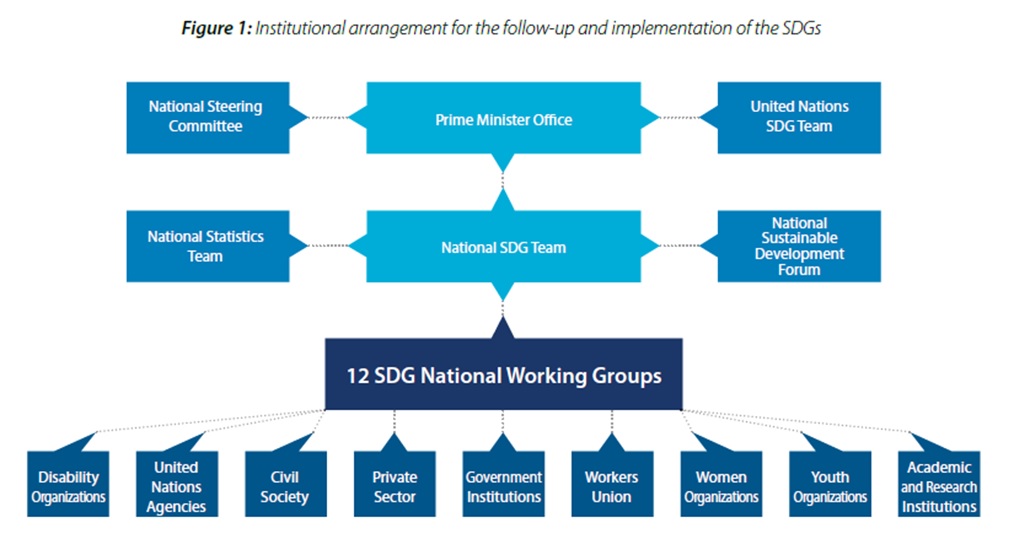 Source: Palestine 2018 VNR
Source: Palestine 2018 VNR
‘The Palestinian Government launched the National Policy Agenda (NPA) for the years 2017-2022 under the slogan of “Putting Citizens First”. The NPA lays the foundation for three pillars for the future of the State of Palestine: path to independence, government reform and improve services to citizens, and sustainable development. The NPA has adopted 75 of the SDG targets, taking into account the impediments of the Israeli occupation, the dire fiscal situation of the Palestinian Government and the sharp decline of donor aid to Palestine.’
Source: Palestine 2018 VNR
National set of SDG indicators
UNSD did an initial technical assessment mission in late 2017 and follow up data modelling workshop in April 2018 to support the continuing work on developing the multidimensional tables for the approved list of national SDG indicators. The UNSD team worked with PCBS counterparts in validating the mappings of the national SDG indicators with the global SDG indicator series and managed to complete the task successfully.
Palestine’s National Policy Agenda NPA (2017–2022), “Citizen First” is consistently aligned to the 2030 Agenda and its Sustainable Development Goals (SDGs). The development of the agenda was followed by the development of a SDG-led National Strategy for the Development of Official Statistics NSDS (2018-2022) which will be revised periodically. The NPA includes 128 SDGs indicators that distributed on the all goals
Source: 2020 Sustainable Development Goals Statistical Report
You can find extensive, indicator-by-indicator information on availability and disaggregation as an annex to the 2018 VNR The recently launched 2020 Sustainable Development Goals Statistical Report that ‘the lack of available data for monitoring the SDGs and their targets remains an obstacle to the implementation of the Agenda.’
SDG reports and Voluntary National Reviews
‘The Palestinian Central Bureau of Statistics (PCBS) is responsible for localizing and monitoring the SDG indicators in cooperation with all relevant ministries and national institutions, and in coordination with international organizations, especially UN agencies concerned with these indicators.’ Source: Palestine 2018 VNR
PCBS upgraded their PxWeb version to disseminate SDG indicators which will also help in supporting dissemination of other domain specific indicators at the national level. PCBS launched the integrated interactive database for the SDGs that integrates the indicator processing system with PxWeb dissemination system in February 2020. The successful launch of the integrated SDGs processing and dissemination environment was made possible through the collaborative work of UNSD-DFID project with an existing project work with The Italian National Institute of Statistics (ISTAT)
The UNSD team also worked with PCBS GIS team working on the PCBS SDG Hub on the Federated Information Systems for SDGs on integrating the work of the newly modelled SDGs data based on the SDMX information system into the national hub. The team showcased the production on Dashboards based on a selected indicator that has geographic disaggregation by localities showing the power of disseminating data when there is indicator data that is highly disaggregated by geography, complimenting the work on integrating statistical and geographic data.
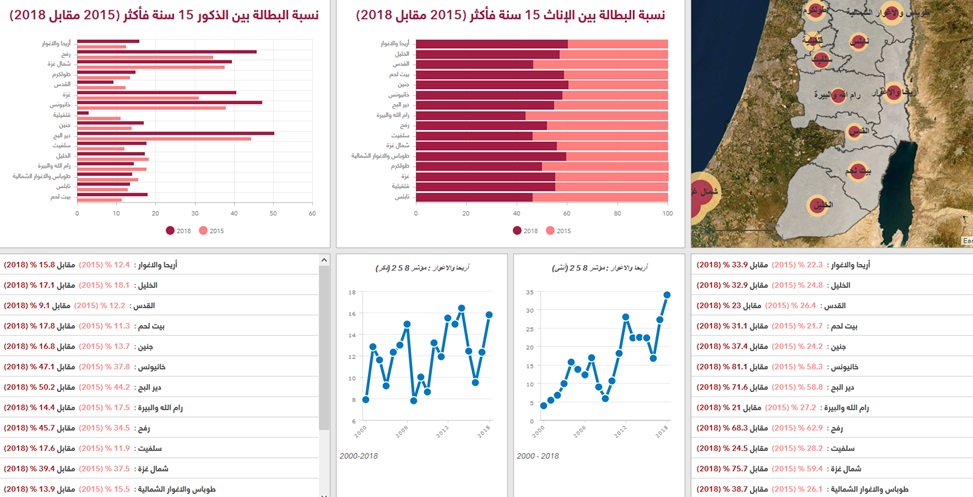
The NSS has an Advisory Council for Statistics headed by the Prime Minister which is ‘a national body comprising representatives from the governmental, non – governmental and private sectors in addition to academic personalities. The membership of the council is determined based on nominations from the council of ministers. This ensures that the composition of the council involves fully qualified personalities along with national and legal personalities capable of giving solid advice on the national statistical priorities.’ Source: PCBS, http://www.pcbs.gov.ps/site/lang__en/542/default.aspx
In addition, ‘the Advisory Council for Official Statistics is a supporting body and a key pillar supporting the development and adoption of methodologies for statistical work and plans and strategies for the development of national statistics. The Advisory Council adopts the national strategy for official statistics, reviews PCBS annual plans, sets priorities and evaluates the performance of the official statistics system. Source: PCBS NSDS
SDG data coordination committees
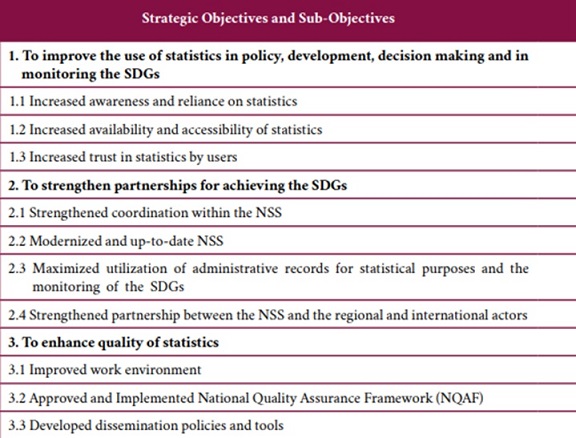 Source: PCBS NSDS
Source: PCBS NSDS
The Overall Strategic Objective of the NSDS for 2018-2022 is to consolidate the statistical infrastructure necessary for monitoring the Sustainable Development Goals (SDGs) as part of the National Policy Agenda 2017-2022. These incudes various objectives and sub-objectives as shown in the table to meet the goals set in the NSDS
‘The State of Palestine has relatively high statistical capacity as well as data dissemination capacity, and good coordination of the National Statistical System. It is possible that some of the activities undertaken in other countries may be found unnecessary in the case of Palestine.’ Source: DFID 2019 Annual Report
Responsibility for SDG indicator compilation
The PCBS has been given the mandate to provide the data on SDGs and to work on monitoring the national indicators in cooperation with the national stakeholders as well as the regional and international partners. Based on the Palestinian NSDS (2018-2022), the statistical program has identified the needs of providing the required data and include the design of activities for all data including SDGs indicators. The work has so far been successfully implemented and a progress report exists which shows this.
On SDG monitoring, ‘the PCBS has updated its data management structure to fulfil its vision of integrating data producers and expanding the use of data from administrative records for statistical purposes. A general directorate of “Records and Statistical Monitoring” was created with the aim of collecting, compiling, publishing and documenting statistics from the administrative records of various public and private institutions and combining it with the data from the findings of surveys and censuses. This is envisaged to facilitate the monitoring of SDG indicators and statistical monitoring indicators at the national level within the social, economic and environmental sectors, according to the national strategic vision and goals. A public database will be made available for researchers, scholars and other users. PCBS also formed an internal technical task force to monitor the methodology and provision of data for SDG indicators. This task force consists of experts in methodology, data quality, spatial information systems and statisticians who are experienced in the social, economic and environmental dimensions of sustainable development, as well as experts in the field of technological information systems and in data collection from various sources.’
The data sharing arrangement include MoUs that have some components on data sharing. ‘The signed MoUs by PCBS and its partners in the NSS are one of the milestones of strengthening the partnership. Those memos also contain common tasks and obligations of each party, which together constitute a timetable for clear tasks and specific outputs. The memoranda of understanding concluded with the partners are considered as a legal framework for regulating the relationship and determining the channels of communication. Consequently, those memoranda facilitate, regulate and advance the statistical work.’ Source: PCBS NSDS
Actual data sharing mechanisms
At the working level, PCBS leads and regularly communicates with statistical units in ministries and government institutions. During the November 2019 metadata workshop, PCBS displayed significant experience in coordination and cooperation with various statistical units within the NSS system.
On the PCBS online platforms, data seems to be generally open to the public free and readily accessible including SDG indicators/data. However, the current NSDS noted as one of the weakness of the NSS as the ‘availability and accessibility of open data for all segments of society (free or fair fee) and their use and participation, which will improve the performance and efficiency of the government sector and increase transparency and accountability.’ To address this issue, the NSDS includes objectives to further develop dissemination policies and tools including ‘the availability of open data in National Statistical Offices (NSOs) facilitates access to data by all segments of society where NSOs and partners can also use evaluation reports on the reality of open data in the strategic planning process and measure the development of their NSS. Such evaluation reports also secure valuable information for data users in the public and private sectors as well as the whole society on the availability of an important statistical series.’ Source: PCBS NSDS
IV. Data availability and disaggregation
Work to make more indicators available
Please see NSDS 2018-22, particularly Sub-objective 1.2 in increased availability and accessibility of statistics. Also, as mentioned above, the lack of available data for monitoring the SDGs and their targets was noted as an obstacle to the implementation of the Agenda.
Work to allow more data disaggregation
Please see NSDS 2018-22, particularly activity 2.3.1.2. Updating the existing manual on the statistical indicators to include new domains and more disaggregation levels (as required by SDGs)
The metadata workshop in November 2019 revealed the localization of SDG indicators is still in progress with many, if not most, indicators missing national/localized metadata. In addition, while the capacity of the PCBS staff is quite high on issues related to SDG indicators, other national authorities (ONAs) within the NSS/SDG monitoring system would benefit from further capacity building efforts on metadata/dissemination/user engagement. The national SDG platform includes sections and links to metadata, but they seem to only include the indicator information which seems to come directly from the global SDG metadata. In other words, they seem to have only the basic structural metadata for SDG indicators now.
PCBS also participated in, and actively contributed to, the international workshop on user engagement held in Amman in June 2019. They impressed many of the other project countries with a very broad approach to user engagement from infographics to games for children and a play showcasing violence against women. They also had good learning from other countries experiences too.
UNSD has supported the Palestine Bureau of Statistics (PCBS) in developing their own COVID-19 data hubs. PCBS were already using the ArcGIS technology to support their day to day operations were able to establish their COVID-19 Data Hub relatively quickly as they were familiar with the technology that supported the establishment of the hub. PCBS has also conducted additional COVID-19 surveys which are also accessible through the data hub providing more insights on the impacts of the pandemic in the society
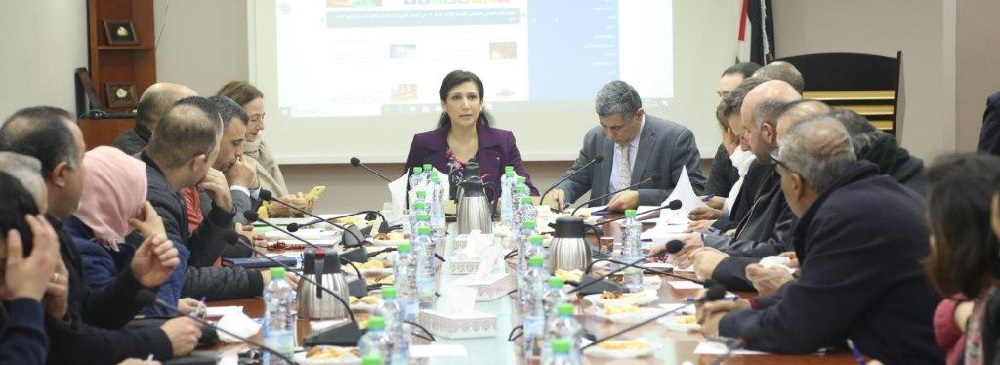
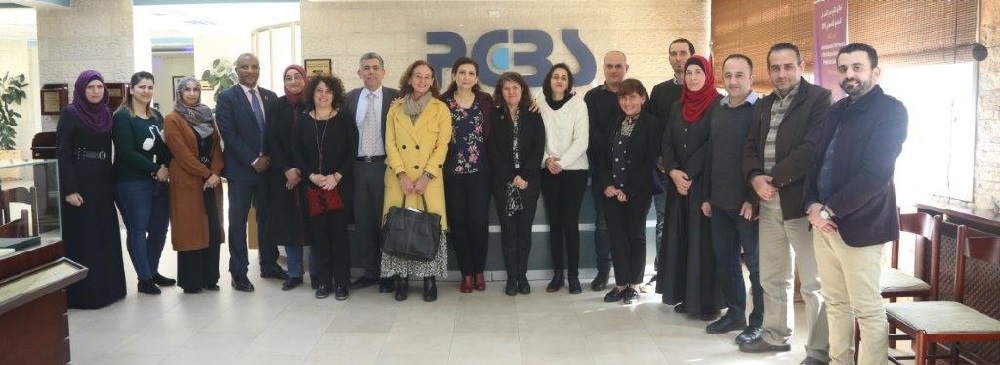
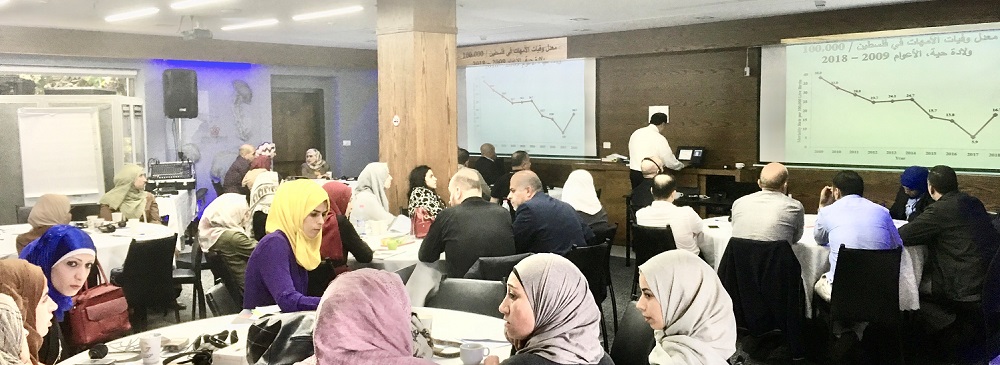
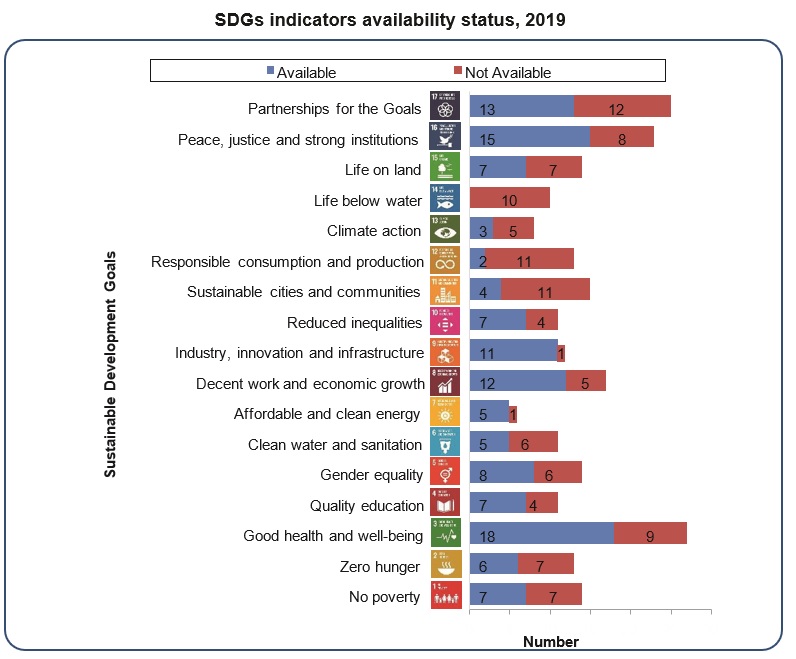 Source:
Source: 